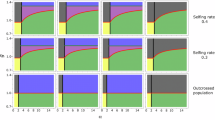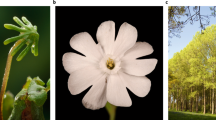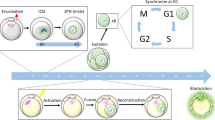Summary
Selection on reproductive phenotype in plants is studied, using a theoretical model. Fitnesses of mutant phenotypes with altered male and female fertility are derived, assuming an initially hermaphrodite or monoecious population with no self-incompatibility mechanism, with partial self-fertilisation, and with some inbreeding depression. These fitness expressions are used to derive conditions for the spread of such mutations, in terms of the minimum increase in opposite-sex fertility that will give a phenotype with reduced male or female fertility a selective advantage over the original type, taking into account the effect on the selfing rate of altering the sex phenotype. Conditions for polymorphism are also obtained. The conditions are used to study the evolution of dioecy from monoecy, and the evolution of gynomonoecy and monoecy from the hermaphrodite state.
Similar content being viewed by others
Article PDF
References
Baker, H G. 1959. Reproductive methods as factors in speciation in flowering plants. Cold Spr Harb Symp Quant Biol, 24, 177–191.
Baker, H G. 1965. Characteristics and mode of origin of weeds. In The Genetics of Colonising Species, eds. H. G. Baker and G. L. Stebbins. Academic Press, New York.
Baker, H G. 1966. The evolution of floral heteromorphism and gynodioecism in Silene maritima. Heredity, 21, 689–692.
Charlesworth, B, and Charlesworth, D. 1978. A model for the evolution of dioecy and gynodioecy. Amer Nat, in press.
Correns, C. 1916. Untersuchungen über Geschlechtsbestimmung bei Distelarten. Sber Preuss Akad Wiss, 20, 448–477.
Cruden, R W. 1977. Pollen-ovule ratios: a conservative indicator of breeding systems in flowering plants. Evolution, 31, 32–46.
Darwin, C. 1876. The Effects of Cross and Self Fertilisation in the Vegetable Kingdom. John Murray, London.
Darwin, C. 1877. The Different Forms of Flowers on Plants of the Same Species. John Murray, London.
Godley, E J. 1955. Monoecy and incompatibility. Nature, 176, 1176–1177.
Jones, D F. 1934. Unisexual maize plants and their bearing on sex differentiation in other plants and in animals. Genetics, 19, 552–567.
Kheyr-Pour, A. 1975. Déterminisme génétique et répartition écologique de la stérilité mâle cytoplasmique chez Origanum vulgare L. Thesis, Univ. des Sciences et Techniques de Languedoc, Montpellier.
Lewis, D. 1942. The evolution of sex in flowering plants. Biol Rev, 17, 46–67.
Lloyd, D G. 1972. Breeding systems in Cotula. II. Monoecious populations. New Phytologist, 71, 1195–1202.
Lloyd, D G. 1973. Sexual dimorphism in Cotula (Compositae). (Abstr.) Genetics, 74, s161.
Lloyd, D G. 1974. Theoretical sex ratios of dioecious and gynodioecious angiosperms. Heredity, 32, 11–34.
Lloyd, D G. 1975a. Breeding systems in Cotula. III. Dioecious populations. New Phytologist, 74, 109–123.
Lloyd, D G. 1975b. Breeding systems in Cotula. IV. Reversion from dioecy to monoecy. New Phytologist, 74, 125–145.
Lloyd, D G. 1975c. The maintenance of gynodioecy and androdioecy in angiosperms. Genetica, 45, 325–339.
Lloyd, D G. 1978. The distribution of gender in four representative angiosperms. Unpublished manuscript.
Lloyd, D G, and Myall, A J. 1976. Sexual dimorphism in Cirsium arvense (L.) Scop. Ann Bot, 40, 115–123.
Martens, J L. 1939. Some observations on sexual dimorphism in Carexpicta. Amer J Bot, 26, 78–88.
Westergaard, M. 1958. The mechanism of sex determination in dioecious flowering plants. Adv Genet, 9, 217–281.
Author information
Authors and Affiliations
Rights and permissions
About this article
Cite this article
Charlesworth, D., Charlesworth, B. Population genetics of partial male-sterility and the evolution of monoecy and dioecy. Heredity 41, 137–153 (1978). https://doi.org/10.1038/hdy.1978.83
Received:
Issue date:
DOI: https://doi.org/10.1038/hdy.1978.83
This article is cited by
-
Morphological and anatomical changes during floral bud development of the trioecious Idesia polycarpa Maxim
Brazilian Journal of Botany (2022)
-
Occurrence of subdioecy and scarcity of gender-specific markers reveal an ongoing transition to dioecy in Himalayan seabuckthorn (Hippophae rhamnoides ssp. turkestanica)
Heredity (2019)
-
Characterization of a large sex determination region in Salix purpurea L. (Salicaceae)
Molecular Genetics and Genomics (2018)
-
The asparagus genome sheds light on the origin and evolution of a young Y chromosome
Nature Communications (2017)
-
Sexual system of Garcinia indica Choisy: geographic variation in trioecy and sexual dimorphism in floral traits
Plant Systematics and Evolution (2015)



